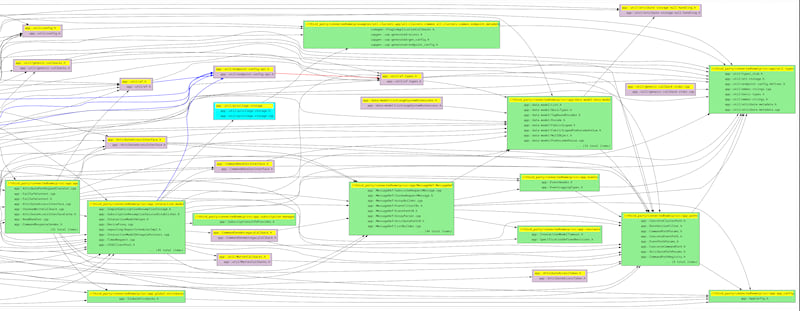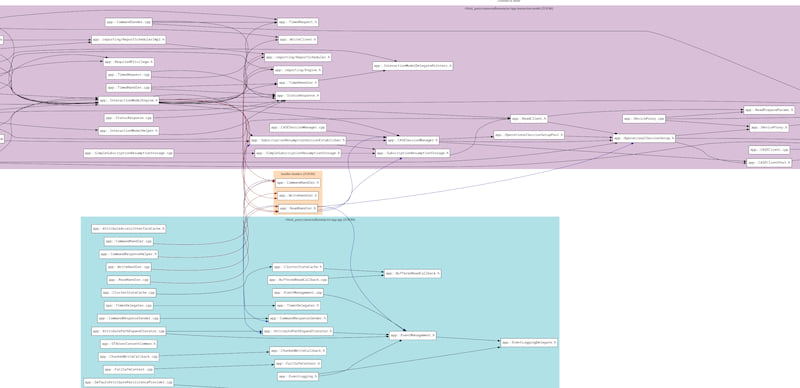15 个稳定版本
| 1.2.2 | 2024 年 3 月 18 日 |
|---|---|
| 1.1.1 | 2024 年 3 月 2 日 |
| 1.0.8 | 2024 年 2 月 28 日 |
#38 在 可视化
1MB
2.5K SLoC
包含依赖查看器
此程序为 c/c++ 的包含头文件生成 dot 图描述。
目的是可视化文件之间的依赖关系。
功能
示例
以下是一个复杂的包含图示例

以下是一个复杂的放大后的依赖组示例

构建
这是一个标准的 Rust 二进制文件
cargo build --release将在target/release/include-graph生成输出cargo run -- <args-here>可用于就地运行(并调试)cargo test或cargo nextest run将执行一些集成单元测试(提高测试覆盖率仍在进行中)
使用方法
# Simple run using a configuration database
# if no `output` is provided, the output will go to standard out
include-graph -c configfile.txt -o outfile.dot
# You should generate the graph using graphviz/dot
# For example for the above `outfile.dot`:
dot -T svg -o outfile.svg outfile.dot
# If you install watchexec, you can setup a pipeline like:
watchexec -e txt -- "include-graph -c cfg.txt -o out.dot && dot -Tsvg -o out.svg out.dot"
配置文件格式
以下是一个带有注释的示例配置文件
# Comments start with `#` and last to the end of the line
# Variables are declared first and you can nest variables
# Expansion is specifically `${name}` (this is not shell, so `$name` will not work)
SOURCE_ROOT=/some/path/to/source
OUTPUT_ROOT=${SOURCE_ROOT}/build/out
# The input section describes what files are to be parsed.
# - what include path should be searched for `#include "foo.h"`
# - what files to be parsed using glob rules
input {
# You may include a compile_commands database which will parse
# includes (find `-I` arguments to a compiler) or sources.
#
# Note that compildb may not include all sources in a directory
# in which case you should use GLOB for full coverage
from compiledb ${OUTPUT_ROOT}/compile_commands.json load include_dirs
from compiledb ${OUTPUT_ROOT}/other_compile_commands.json load sources
from compiledb ${OUTPUT_ROOT}/third.json load sources, include_dirs
# You may also manually include single directories
include_dir ${SOURCE_ROOT}/includes/test
include_dir /third/party/lib
# Globs are generally including all files. program filters
# out based on extensions (h, hpp, c, cpp, cxx, cc)
glob ${SOURCE_ROOT}/src/lib1/**/*
glob ${SOURCE_ROOT}/src/lib2/**/*
}
# The graph section defines how to setup the graph.
graph {
# The tool works with absolute paths when parsing includes
# the `map` section describes how to shorten typically long
# absolute paths like `/home/user/devel/some/path/....`
map {
# Replace some long poath with a short prefix
${SOURCE_ROOT}/src/lib1 => first::
${SOURCE_ROOT}/src/lib2 => second::
# This defines what items to actually keep in the output. Not
# all includes are kept as they would be generally too large.
#
# Only prefix-paths are used here
keep first::
keep second::
# Explicitly remove some of the kept items
drop first::tests/
drop second::support/library
}
# The group section defines how the graph should place
# things together for easy dependency view.
# Group logic:
# - they must be in order of application
# - first group wins (a file belongs to one group only)
group {
# This loads build targets from GN:
# - compile_root is where the `gn` too will be pointed to
# - target defines what GN target to grab `sources` from
# - sources will translate gn paths of `//foo` into absolute
# system paths
gn root ${OUTPUT_ROOT} target //src/app/* sources ${SOURCE_ROOT}
# Groups can be manually defined to group some files
manual group-name-here {
# Grouping is done by mapped names
first::platform/Header.h
first::platform/Src.cpp
first::Something.cc
}
# Manual groups may have an optional color
manual group-name-here color lightblue {
# Grouping is done by mapped names
first::some/other_header.h
}
# Optional instructions to ensure headers and sources
# are grouped together (as they are generally included in
# the same compilation unit)
group_source_header
}
# you can optionally provide instructions for edge coloring
color edges {
from some_group_name red
# color may be prefixed with "bold" for a bold edge coloring
to other_group_name bold blue
}
# If zoom is non-empty it generates a separate area
# with the specified "groups" expanded and viewing individual
# members and dependencies
zoom {
# The zoom takes the group name argument, which could
# be the GN group name or the manual group name
//src/library:support
group-name-here
# Focus prefix means to focus on determining dependencies
# in and out of the specified group(s).
#
# Dependences from other zoomed items will only be show
# if internal or they start/end in a focused zoo group
focus: //src/library:foo
focus: //src/something/else:else
}
}
调试日志
程序使用 env_logger 进行日志配置。
您可以将 RUST_LOG 环境变量设置为控制更多详细日志。请注意,它可能非常详细。
包含处理
使用 RUST_LOG=include-extract=info 打印所有解析的包含信息
使用 RUST_LOG=full-file-list=info 打印通过 glob 查找源文件找到的所有文件
使用 RUST_LOG=gn-path=info 来打印出由glob模式匹配到的所有源文件。
使用 RUST_LOG=compile-db=info 来打印出从编译数据库中解析的信息。使用 RUST_LOG=compile-db=debug 来调试编译数据库的解析。
发布
通过 cargo-smart-release 来使用,首先通过 cargo install cargo-smart-release 安装,然后执行 cargo smart-release。
使用 cargo smart-release -h 来查看智能发布的标志。
依赖项
~18–30MB
~440K SLoC